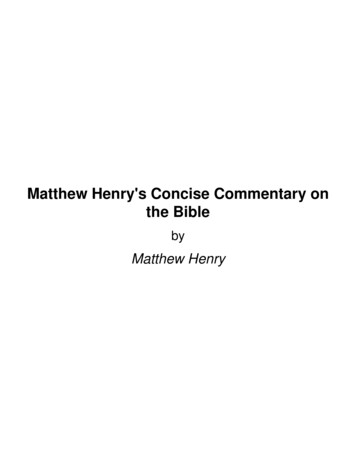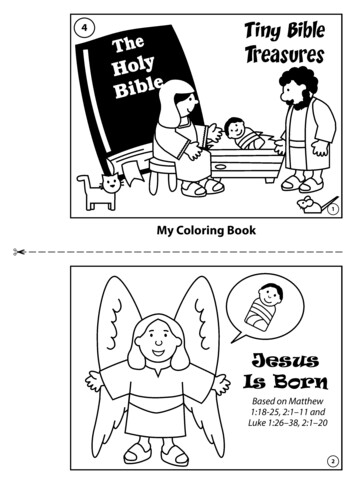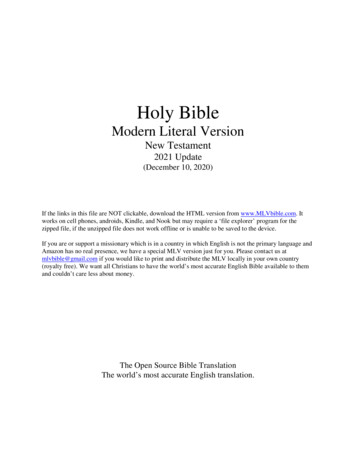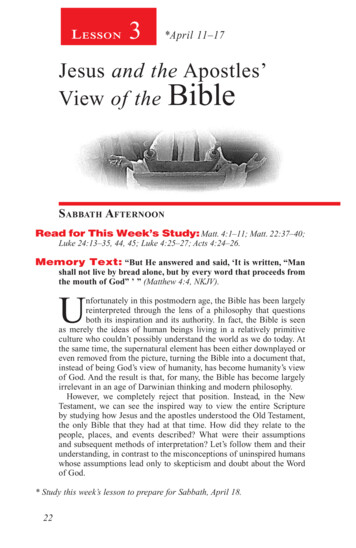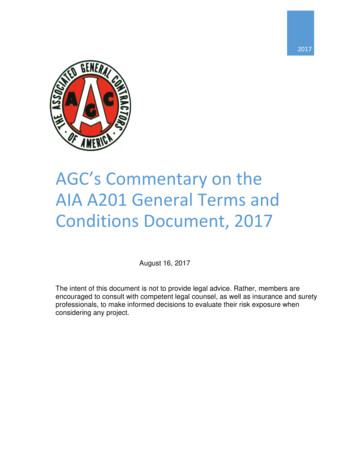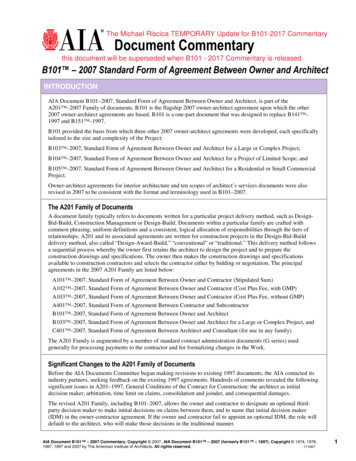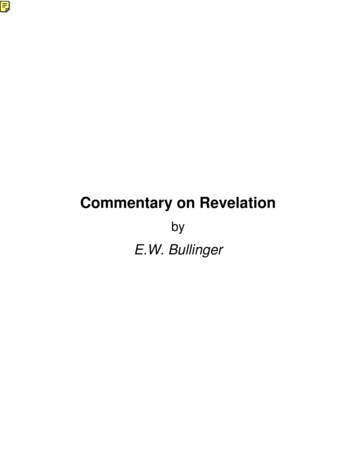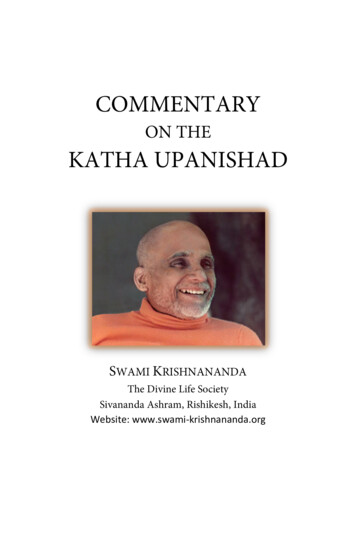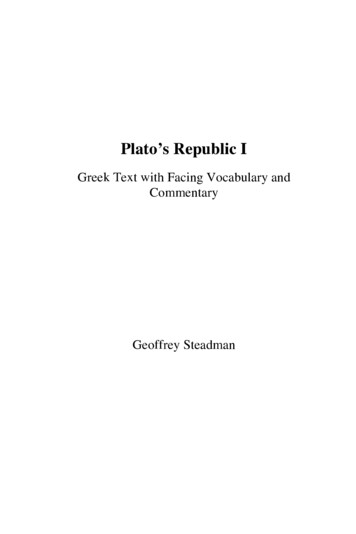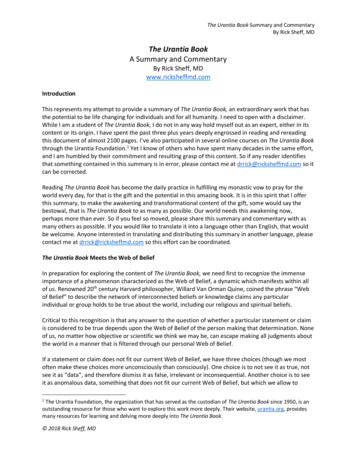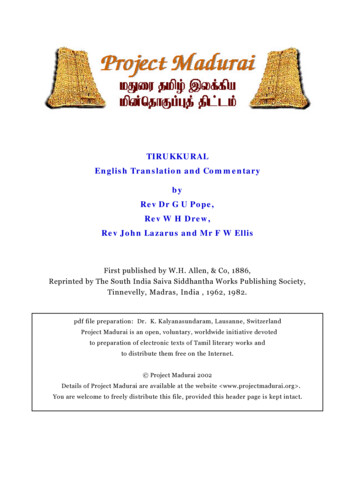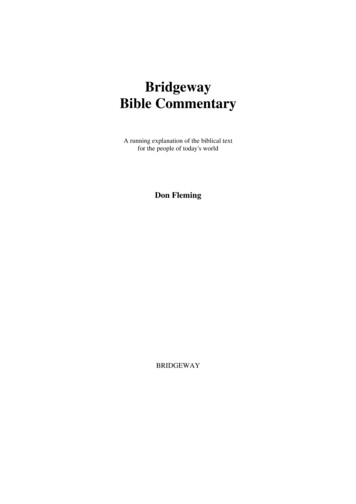
Transcription
BridgewayBible CommentaryA running explanation of the biblical textfor the people of today's worldDon FlemingBRIDGEWAY
Bridgeway Bible CommentaryDon Fleming 1988, 1994, 2005First published in an 8-volume set as Bridge Bible Handbooks 1988Reprinted 1990, 1992First published as Bridge Bible Commentary 1994Reprinted 1997, 2001, 2003First published as Bridgeway Bible Commentary 2005ISBN 0 947342 72 9All Rights ReservedBridgeway PublicationsGPO Box 2547Brisbane 4001Australia
onomyJoshuaJudgesRuth1 Samuel2 Samuel1 Kings2 Kings1 Chronicles2 siastesSong of SongsOld Testament eaJoelAmosObadiahJonahMicahNahum
HabakkukZephaniahHaggaiZechariahMalachiThe New Testament WorldIntroduction to the Four GospelsJesus and the KingdomIndex to the Four GospelsThe Four GospelsActsThe post-Acts PeriodRomans1 Corinthians2 1 Thessalonians2 Thessalonians1 Timothy2 TimothyTitusPhilemonHebrewsJames1 Peter2 Peter1 John2 John3 JohnJudeRevelation
PrefaceThe origins of this commentary go back to my missionary years in Thailand, when I began writing afew books in the Thai language to help local people understand the Scriptures. The result, after manyyears, was a series of fifteen mini-commentaries on the Thai Bible.Although the success of the books in Thai was due largely to the lack of available alternatives, newsof the books spread, and it was suggested that I prepare an English equivalent for use in other countries.Over some years the fifteen-volume series was produced in English, but by this time I had written severalother books and their production was scattered over a variety of countries.When Bridgeway Publications in Australia undertook a project to republish all these books in a newformat, the fifteen volumes were revised and reissued in eight volumes under the series title, Bridge BibleHandbooks. Those eight books are now combined into the one-volume Bridgeway Bible Commentary,which is a companion in size, style and format to the Bridgeway Bible Dictionary, an A to Z of biblicalinformation.The eight Handbooks were dedicated to people who, in different ways, had a significant influence inmy life and ministry. Since the present volume is not a new work but a reformatted (and in parts revised)version of the eight Handbooks, no new dedication attaches to it. Instead I am pleased to acknowledgeagain my indebtedness to those to whom the earlier editions were dedicated.Book 1Philip and Pat JulerBook 2Chun KertyooBook 3Reg and Marjorie VinesBook 4David ClinesBook 5John and Grace RobertsonBook 6Bob and Vic McCallumBook 7Chue PetnamngernBook 8Vic and Jean FlemingIn the present book, as in my other books, my aim is to provide biblical reference material thatbridges two gaps at the same time. First, I want to bridge the gap in time and culture between the world ofthe Bible and the world of today. Second, I want to bridge the gap between the technical reference worksand the non-technical reader. Above all, my desire is to produce books that will encourage people to readthe Bible.Though labelled a commentary, this volume is not a word-by-word or verse-by-verse technicalreference book. But neither is it a survey that flies over the top of the various biblical books withouttouching the text. Perhaps ‘running commentary’ would be a more appropriate description.My suggestion is that instead of trying to ‘dig deep’ or ‘squeeze lessons’ from the Bible, we relax alittle, try to understand what each book is saying, and then let the Bible do whatever it wants to do. ‘Letthe Bible speak for itself’ – which is the title of a practical handbook I have written on how we mightteach the Bible in plain language. The aim of such teaching, like the aim of this commentary, is not toexhaust the meaning of the text, nor to force the text to fit our schemes of interpretation, but to provideenough background and comment to enable people to read with understanding.The Bible has its own power as God’s Word, and is an authoritative standard for teaching truth,correcting error, and instructing in right living. It is living and active, and has its own way of making itsmessage relevant to us as readers, but it can do so only if first we understand it. This commentary isdesigned to help us understand what the biblical writers might have meant, and to do so in such a way thatwe might readily see the relevance of the ancient Word to present-day living. And once we have theunderstanding, we have an obligation to act upon it.Don Fleming
GenesisINTRODUCTIONThe name Genesis means ‘origin’ or ‘beginning’ and is a suitable name for the book of the Bible thatspeaks of the origins of the universe, of the human race, of human sin and of God’s way of salvation.Though it stands at the beginning of our Bibles as an individual book, it was originally part of a muchlarger book commonly called the Pentateuch.The PentateuchHebrew, the mother tongue of the Israelite people, was the original language of the Old Testament.During the third century BC this Hebrew Old Testament was translated into Greek, the translation beingknown as the Septuagint (often written LXX), after ‘the seventy’ who translated it. From these translatorswe have borrowed the word Pentateuch as a name for the first five books of the Bible (from two Greekwords, penta, meaning ‘five’, and teuchos, meaning ‘a volume’).Originally the five books were one, but they were put into their present five-volume form so that theycould fit conveniently on to five scrolls. The Hebrews referred to the whole Pentateuch simply as ‘thelaw’ (2 Chron 17:9; Neh 8:1-3,18; Matt 5:17-19; 11:13; 12:5; Luke 24:44).Age-old tradition, both Hebrew and Christian, recognizes Moses as the author of the Pentateuch (2Chron 35:12; Neh 8:1; 13:1; Dan 9:11; Mark 12:26; Luke 16:29-31; Acts 15:21), though the Pentateuchitself does not say who wrote it. Nevertheless, it mentions Moses’ literary activity. He wrote down thelaw that God gave to Israel (Exod 24:4; 34:27; Deut 31:9,24), he kept records of Israel’s history (Exod17:14; Num 33:2) and he wrote poems and songs (Exod 15:1; Deut 1:22,30).As leader of the nation, Moses was no doubt familiar with the family records, traditional stories andancient songs that people of former generations had preserved and handed down, whether by word ofmouth or in written form (cf. Gen 5:1; 6:9; 10:1; 11:10,27). Like other writers, he would have usedmaterial from various sources, especially in writing about places and events outside his own experience(Gen 26:33; 35:19-20; 47:26; Num 21:14). In addition he had direct contact with God and received divinerevelations (Exod 3:4-6; 33:9-11; Deut 34:10). Under the guiding hand of God, all this material was puttogether to produce what we call the five books of Moses.People who study biblical documents have at times suggested that the Pentateuch reached its finalform much later than the time of Moses. They base their ideas on the similarities and contrasts they see insuch things as narrative accounts, the names used for God, usage of certain words and phrases, and detailsof Israel’s religious system. Some even see a number of independent documents that were later combinedinto one.Amid all the discussion that has taken place concerning these matters, people have sometimesforgotten that the important issue is not how the Pentateuch was written, but what it means. And in boththe Hebrew and Christian Bibles it stands as a book whose unity is clear and whose message is the livingWord of God (Neh 8:8,14; 9:3; John 5:39,46; Acts 28:23).The book of GenesisThose who gave the name ‘Genesis’ to the first book of the Bible were the translators of thePentateuch. The ancient Hebrews called the book by its opening words, ‘In the beginning’. The book’schief concern, however, is not with physical origins, but with the relationship God desires to have withthe people who inhabit his earth.Adam and Eve, though sinless when created, fell into sin, and the evil consequences of their sinpassed on to the human race descended from them. Rebellious humanity deserved, and received, God’sjudgment, but that judgment was always mixed with mercy. God did not destroy the human life he hadcreated. Rather he worked through it to provide a way of salvation available to all. His way was to chooseone man (Abraham), from whom he would build a nation (Israel), through which he would make his willknown and eventually produce the Saviour of the world (Jesus).The book of Genesis shows how human beings rebelled against God and fell under his judgment, butit shows also how God began to carry out his plan for their salvation. After recording his promises to
make from Abraham a nation and to give that nation a homeland in Canaan, it shows how the promisesconcerning both the land and the people began to be :1-50:26The story of creationEarly human lifeGenealogy from Adam to NoahRebellion and judgmentGenealogies from Noah to AbramAbram’s entry into the promised landAbram and the promised heirIsaac passes on the inheritanceJacob establishes the familyFamily growth and the move to Egypt1:1-2:3 THE STORY OF CREATIONThe Bible and scienceModern science has revealed so much about the wonders and the size of the physical universe thathuman beings may seem almost to be nothing. The Bible takes a different view. Human beings are itsmain concern, for they alone are made in God’s image. The story of creation is but an introduction to thestory of God’s dealings with the human race. The Bible demonstrates this order of importance from theoutset by fitting the story of creation into a mere week, into the opening page of a 1,000-page Bible.The Bible was never intended to be a scientific textbook. It is not concerned with the sort ofinvestigation that modern science is concerned with. If its language were that of modern science, peoplein former ages would not have understood it, and people in future ages would find it out of date. Thepurpose of the Genesis account of creation was not to teach scientific theories, but to give a short simpleaccount of the beginning of things in language that people of any age would understand.Language of the BibleAs with the rest of the Bible, the book of Genesis was written in the everyday language of the peopleof the time. For example, the Bible speaks of the four corners of the earth (Isa 11:12) and of the pillars,bases and cornerstone of the earth (Job 9:6; 38:4-6); but if people use those statements to deny that theearth is a globe, they misuse the Bible. They show a misunderstanding of the nature of the Bible’slanguage.Yet such misunderstandings occur. Centuries ago people thought that the sun moved round the earth,but when one scientist suggested that the earth moved round the sun, he was condemned for not believingthe Bible. The argument his accusers used was that the Bible says the earth remains still and the sun risesand sets upon it (1 Chron 16:30; Eccles 1:5).The Bible speaks of the heavens and the earth as ordinary people see them from their standpoint onearth. The scientist may speak of the sun as the centre of the solar system, with the earth a minor planet ofthe sun, and the moon a small satellite of the earth. But to people of ancient times, and even to us today,the earth where people live is the centre of their world. The sun is merely the ‘greater light to rule theday’, and the moon the ‘lesser light to rule the night’.In reading the Bible we must understand not only what the Bible says but also what it means. When itsays that God ‘sits above the circle of the earth’ (Isa 40:22), it does not mean that he sits in spacesomewhere above the horizon, but that he is the sovereign Lord of the universe. Likewise when it saysthat God ‘made man from the dust of the earth’ (Gen 2:7), it does not mean that he took in his hands aball of clay and formed it into a human shape as a baker makes a gingerbread man, but that he made manout of common chemicals. Even we ourselves, who came by natural processes of birth, are said to beformed out of clay and made from the dust of the earth (Job 10:9; Eccles 3:20).The Creator at workGod is pleased when people study his creation and learn its wonders (Ps. 111:2). The Bible tells usthat God is the Creator, and it reveals something of his purposes in creation, but if people want to find out
how the physical creation functions, they must do so by hard work as God has appointed (Gen 3:19). Goddoes not give such knowledge by direct revelation. How the various organs of the human body function,for example, is a problem for medical science to solve, not the Bible. The same principle applies in otherfields of science.Science may tell us more about God’s creation, but it does so from a viewpoint that is different fromthat of the Bible. The Bible tells us that God is the one who did these things, and the scientist tells how hemight have done them.When the Bible says ‘God did this’ or ‘God created that’, it does not mean that he must have done soinstantaneously or ‘magically’. We pray, ‘Give us this day our daily bread’ (Matt 6:11), but we do notexpect God to work instantaneously and drop food from heaven on to our plates. We expect him to workthrough the normal processes of nature in producing the crops from which we get our food by hard work.Yet we still thank God, for we know that he is the provider of all things. Believers and unbelievers mightagree on how nature provides humankind with food, but believers add something extra, because they seeGod working through nature. The ‘laws of nature’ are God’s laws. Science may investigate the physicalworld and suggest how something happened, but it cannot say who made it happen. Believers can, for ‘byfaith we understand that the world was created by the word of God’ (Heb 11:3).Believers may therefore hesitate to dismiss a scientific theory simply by saying, ‘But I believe Goddid it’, because the theory may have been the way God has done it. When the scientist tells us how rainsfalls or how grass grows, we do not contradict him by saying, ‘But the Bible says God makes the rain fall,God makes the grass grow’ (Matt 5:45; 6:30). We accept both as true.Plan of the Genesis accountAs we might have expected, the Genesis account of creation is from the viewpoint of the ordinaryperson. The story is recorded as if someone were describing creation, not from somewhere in outer space,but from his dwelling place on earth. The earth is only a very small part of God’s creation, but thecreation story in the Bible is concerned mainly with the earth and mentions other features only in relationto the earth.The Genesis account is concerned with showing that God made everything out of nothing, that heworked from the formless to the formed, from the simple to the complex. It outlines how he brought theuniverse through various stages till his creative activity reached its climax in Adam and Eve. Its basicdesign is to divide the creation story into two groups of three days each. The first group shows how Godcreated the basic spheres of operation (light and dark; sea and sky; fertile land), the second how hecreated the features within each of those spheres (lights of day and night; creatures of sea and sky;creatures of the land).This simple creation story, though not intended to be a scientific account, is not in conflict withscience. The following notes suggest one way in which scientific knowledge, far from causing us to doubtthe Genesis creation story, may in fact give us a more meaningful view of it.The creation (1:1-2:3)Countless years ago God, by his sovereign power and will, created the universe. At first the earth wasfeatureless and in darkness because of the mass of surrounding water, but as the thick clouds of watervapour began to lose their density, a hazy light came by day from the invisible sun (1:1-5; first day). Asthey lost further density, the surrounding clouds of vapour gradually rose from the earth, producing aclear distinction between the ocean’s surface below and the ceiling of heavy cloud overhead (6-8; secondday). Meanwhile the earth was drying and land became visible. Simpler forms of life then began toappear. Various kinds of soils and climatic conditions produced various kinds of plants, which were socreated as to continue producing further plants of their own kind (9-13; third day).The heavy cloud overhead, which had been becoming thinner and thinner, finally broke. The sun,moon and stars, previously hidden, now became clearly visible. Their effect upon the earth helped toproduce a variety of weather and a pattern of annual seasons (14-19; fourth day).As God’s creative activity moved on, animal life began to appear, with creatures in the sea andcreatures in the air, all of them suited to their environment (20-23; fifth day). The land also experiencedthis development of animal life, till it too became full of all kinds of creatures. Finally came the firsthuman couple, who together represented the peak of God’s creation. Like the other animals, they were so
made that they could feed themselves from what grew on the earth and reproduce their own kind. Butthey were different from all other animals and were given power over them; for they alone, of all God’screatures, were made in God’s image (24-31; sixth day). (See ‘The image of God’ below.)God’s rest after the creation of the first human couple signified not that he had become tired orinactive (for he continues to care for what he has created), but that he had brought his work to its goal.Having prepared the natural creation for human life, God now desired humankind to enjoy that creationwith him (2:1-3; seventh day).The image of GodBeing made in God’s image, human beings are unique in God’s creation. Somehow they are like Godin a way that nothing else is. This does not mean simply that certain ‘parts’ of human beings such as theirspiritual, moral or mental capacities reflect the divine nature. The whole person is in God’s image.Because of this expression of God within them, men and women are in a sense God’s representativesupon earth. He has appointed them rulers over the earthly creation (see 1:27-28).Without the image of God within them, people would not (according to the biblical definition) behuman. Even if they had the physical appearance of human beings, they would be no more than creaturesof the animal world.An animal’s ‘animality’ is in itself; a person’s humanity is not. It depends for its existence upon God.That is why human beings, in spite of the dignity and status given them by God, cannot existindependently of God. They may want to, and may bring disaster upon themselves as a result (as seen inthe story of their original disobedience; see notes on 2:8-17, 3:1-24 below), but they cannot destroy theimage of God. The image of God within them is what makes them human.2:4-4:26 EARLY HUMAN LIFELife in the Garden of Eden (2:4-25)From this point on, the story concentrates on the people God made, rather than on other features ofthe created universe. Again the Bible states that the world was not always as it is now, but was preparedstage by stage till it was suitable for human habitation. God created Adam (meaning ‘man’ or ‘mankind’)not out of nothing, but out of materials he had previously created. Like the other animals, Adam had hisphysical origins in the common chemicals of the earth, but his life existed in a special relationship withGod that no other animal could share (4-7).This status of existing in God’s image brought with it the responsibility to respond to God’s purposes.God therefore placed Adam in a chosen locality, a beautiful parkland, for his training and testing. Thisparkland was part of a well watered territory known as Eden, situated somewhere in the region ofMesopotamia (8-14).With a variety of foods available and a variety of tasks to be carried out to maintain the garden, Adamhad plenty of opportunity to develop in mind and body. He could mature through making choices andlearning new skills. God’s instructions showed that he wanted the people of his creation to enjoy thefulness of their unique life (to eat of the tree of life), but they had to do so in submission to him. Theircreation in the image of God meant they could not be independent of God. They did not have theunlimited right to do as they pleased, to be the sole judge of right and wrong (to eat of the tree of theknowledge of good and evil) (15-17).Whether we see the two trees as metaphorical or literal, their meaning is the same. The emphasis inthe story is not that the trees were magical, but that they presented Adam with a choice of eithersubmitting to God or trying to be independent of him. Growth in devotion to God involves self-denial(Heb 5:8). Maturity comes through choosing the good and refusing the evil (Heb 5:14), and each victoryover temptation would have helped Adam grow from a state of childlike innocence into one of adultmaturity. His fellowship with God would have deepened, and his understanding of God’s purposesincreased.Because human life alone existed in God’s image, none of the other creatures could share this life inany satisfying way. God therefore gave Adam one of his own kind, but of the opposite sex, to be hiscompanion. The man and the woman were equal in status as being made in God’s image (cf. 1:27) andwere harmoniously united, to the exclusion of all others (18-25). The woman was later given the name
Eve, meaning ‘life’ or ‘living’, because she was the one through whom future human life would come(see 3:20).Human disobedience (3:1-24)Since human beings were made in God’s image, and since God was unlimited, the first human couplesoon showed that they too wanted to be unlimited. They had to remember, however, that they were notGod; they were only creatures made in the image of God. Just as the image of the moon on the watercould not exist independently of the moon, so they could not exist independently of God. Theirrelationship with God contained an element of dependence, or limitation, and consequently God limitedtheir freedom. He told them not to eat of the tree of the knowledge of good and evil.Satan, the opponent of God and chief of the evil angels, set out to spoil the relationship between Godand those created in his image. His evil work was to tempt them to go beyond the limit God had set, to beindependent of God, to put themselves in the place of God, to make their own decisions, to rule their ownlives, to be the independent judges of right and wrong. The root sin was pride – the desire people have tobe their own god – and through this, Satan successfully tempted them to rebel against God (3:1-7). (Forthe identification of the snake with Satan see Revelation 12:9.)In a sense the man and the woman gained a knowledge of good and evil, but from the standpoint ofguilty sinners, not from the standpoint of a holy God. They knew evil through doing it, and the result wasa feeling of shame (8-13).As for the deceiver Satan, his humiliation would be symbolized in the snake’s wriggling in the dirt.Henceforth, the human race (the descendants of Eve) would be in constant conflict with Satan. Yet Godpromised them victory over Satan. A snake might injure a man by biting his heel, but a man can kill asnake by crushing its head. Humankind had been successfully attacked by Satan, but through Jesus Christhumankind would eventually conquer Satan, though the conquest would involve suffering (14-15).The disorder created by human sin brought with it suffering for the whole human race. From this timeon, people could live in God’s world and reproduce their own kind only through suffering. Conflictentered human relationships, and even the harmony between husband and wife became spoiled throughdomination (16-21).No longer were human beings at peace with God. They had rejected eternal life, and therefore Godwithheld it from them. They had wanted to be independent of God, and therefore God sent them awayfrom his presence. They had wanted to determine good and evil for themselves, and therefore God drovethem into a world where they would learn good and evil only through the sorrow and hardship created bytheir own mistakes (22-24).Sin and human deathAccording to the Bible, human death is a result of sin (Rom 5:12). Yet it would seem from the natureof the human body that physical death is inevitable, whether sin is present or not. Is there a solution tothis problem?Adam was warned that on the day that he sinned he would die (see 2:17). When he sinned, he passedout of a condition where life dominated into one where death dominated. His whole being was affected,so that spiritually he was cut off from eternal life and physically he was certain to die (Rom 5:12-17). Thesaving work of Christ reverses the effects of sin, bringing victory over death in both its spiritual andphysical aspects (Rom 6:23; 8:10-11; 1 Cor 15:21-22). Christ restores people, in the totality of theirbeing, to the life that is proper to them, eternal life.Some may argue that since human beings are creatures of the natural world, their lives are controlledby the laws of nature and therefore they must die as other animals do (Eccles 3:19-20). But the Bibleshows that human beings are not simply creatures of the natural world. They are related to God in a waythat makes them different from all other creatures.It has been suggested that before Adam sinned, the spiritual life within him was so dominant that itprevented those natural processes towards bodily decay that we might normally expect. Sin so changedthe situation that bodily decay could no longer be prevented and death became inevitable. If this was thecase, physical death became at the same time a completely natural process and completely a result of sin.
Where the spirit had complete control over the body death could not occur, but once it rebelled againstGod it lost control over the body and death resulted.We need not imagine the chaos of an over-populated world had sin and death not entered, with peoplebeing born but never dying. It is death that is the enemy, not the termination of earthly existence. Deathhas its ‘sting’ because of sin, but there may be some way of departing this world that has no such sting(1 Cor 15:26,55-56; cf. Gen 5:24; 2 Kings 2:11; 1 Cor 15:51-52; Heb 11:5).Results of sin in the natural worldConcerning the death of other forms of life before the entrance of sin through Adam, we need not tryto picture a world in which death never occurred. It is human death that is the consequence of sin. Even inthe ideal conditions of the Garden of Eden, fruit and leaves died as they were separated from the treesthey grew on (see 2:15-16). Wild creatures existed before Adam sinned (see 3:1). Tigers, sharks and anteaters no doubt fed on other animals and helped then, as they do now, to keep the balance of nature.God did not create the world as one great paradise, nor did he intend human beings to spend theirdays in lazy idleness. It seems, in fact, that most of the world was untamed and awaited the arrival of thehuman race to enter its full glory (Rom 8:19-23). The duty of Adam and his descendants was to bring theearth under human control, something they would gradually achieve as their numbers increased andpeople moved out from Eden into the world beyond (see 1:28). But instead of being the means of God’sblessing to nature, they themselves fell into disorder.The ideal conditions of paradise existed only in the Garden of Eden, where God placed the firsthuman couple for their training and testing. When they sinned, they were driven from this garden into theuntamed world outside. But because they had lost the spiritual life that God had given them, the physicalcreation that God intended for their development became the means of their torment. Physical effort andbodily functions that should have brought pleasure brought instead pain and hardship (see 3:16-19).Cain and Abel (4:1-16)Adam and Eve’s first two sons, Cain and Abel, maintained a belief in God and presented offerings tohim. Abel offered the best of his flock in humble faith and God accepted him. Cain’s attitude wasarrogant and his life ungodly, and therefore God rejected him (4:1-5; cf. Heb 11:4; 1 John 3:12). Since theattitude and conduct of the offerer were more important than his gifts, God told Cain that if he wantedGod to accept him, he would have to overcome the sin that threatened to destroy him. That sin was like awild beast crouching at the door, waiting to attack its victim (6-7).Cain failed to overcome his sin and in jealous anger he killed Abel. His taking of Abel’s life calledout for revenge from the one who had given that life. God therefore drove Cain into the barrencountryside, away from the place where people, though sinners, at least still worshipped God. AlthoughCain remained unrepentant, God in his mercy protected him from any possible revenge killing (8-16).Cain’s followers and Seth’s (4:17-26)Difficult though this new way of life was, the ungodly Cain was no doubt relieved to be free from theinfluence of God. The human population had been growing constantly, so in a plan to make himselfsecure Cain established his own independent settlement (17-18).The beginnings of settled life were marked by both good and evil. People made some progress in theraising of sheep and cattle, and developed skills in various arts and crafts, but morally they became worse.Lamech not only murdered a boy who had done no more than slightly injure him, but wrote a song tocelebrate his crime. Cain had at least looked for, and received, God’s protection against revenge killing,but Lamech was so arrogant and defiant that he challenged anyone to take action against him (19-24).Cain’s descendants now disa
Language of the Bible As with the rest of the Bible, the book of Genesis was written in the everyday language of the people of the time. For example, the Bible speaks of the four corners of the earth (Isa 11:12) and of the pillars, bases and cornerstone of the earth (Job 9:6; 38:
